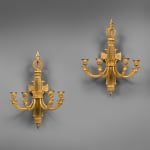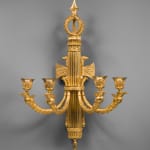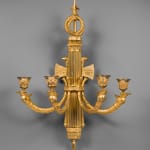Gérard-Jean Galle
Further images
Literature
Hans Ottomeyer and Peter Pröschel, “Vergoldete Bronzen”, 1986, p. 396, pl. 5.18.8, illustrating a pair of candelabra with Mars and Minerva by Gérard-Jean Galle, which have a similar fasces-shaped shaft and very similar candle branches and were supplied by Galle in 1821 to the Royal Palace Stockholm.
A fine pair of Restauration gilt bronze four-light wall-lights possibly by Gérard-Jean Galle, each surmounted by a spearhead above two interlocking laurel leaf wreaths, the central spear arising from the shaft formed as fasces composed of bundles of tassel-hung spears. The upper part of the shaft flanked by two outward facing eagle heads, each above an anthemion cast axe head, with a rosette and foliate ring around the centre of the shaft, from which issue four foliate-wrapped scrolled candle branches, each with a horn-shaped end toward the shaft and terminating at the outer end as an open beaked swan head supporting a vase-shaped candle nozzle cast with stiff leaves, with a rosette cast ring around the base of the shaft above the butt of the central upright spear
Paris, date circa 1820
Close parallels can be drawn between the various decorative elements and the design of the present wall-lights with a pair of candelabra with the figures of Mars and Minerva that were supplied in 1821 by Gérard-Jean Galle (1788-1846) to the Swedish King Carl XIV Johan for the Royal Palace at Stockholm (illustrated in situ in Prince Frederik Adolf’s Anteroom in Håkan Groth, “Neoclassicism in the North: Swedish Furniture and Interiors 1770-1850”, 1990, p. 22, pl. 6). Notably, as here, each shaft is formed as fasces, composed of a group of spears enclosing an axe bound by straps. Equally significant are the shapes of the lower candle branches which terminate in the same open-mouthed swan heads supporting vase-shaped nozzles. Furthermore, the inner part of the candle branches each terminate in horn-shaped ends. Gérard-Jean Galle was the son of the celebrated bronzier Claude Galle (1759-1815) who had previously supplied candelabra similar to those at Stockholm Royal Palace, among which is a candelabrum with overt military trophies of 1805 which has a central fasces and row of candle branches terminating in similar swan heads (Atkins Museum of Fine Arts, illustrated in Ottomeyer and Pröschel, p. 391, pl. 5.17.5). Given the similarity between candelabra by Claude Galle and especially those by his son, there is a strong argument to attribute the present wall-lights to Gérard-Jean Galle.
These handsome wall-lights embody the spirit of the Empire period in which Napoleon sought to model his rule on the ancient Emperors, where military prowess and allegiance to one’s country was paramount. Fasces were used in combat by Roman lictors and were also emblems of higher Roman magistrates to signify their authority to scourge and behead. They were also a symbol of justice and as such were adopted as symbols of the French Revolution. At the summit we see a spearhead piercing a pair of laurel wreaths. These were inspired by ancient Imperial military wreaths awarded to victors in battle and at various sporting events. Below are eagle heads which again were symbols of victory and strength, with the eagle also being an attribute of Jupiter, the chief Olympian deity. In contrast the candle branches terminate in swan heads. Swans became an important motif within the decorative arts from the Consulate onward. The Empress Joséphine particularly admired these birds and ordered swans from the Bass Straits for the park at Malmaison while inside the palace, her bedroom suite included a gilded bed with cornucopias and swans at its feet. Swans also adorned a bed made by Jacob-Desmalter circa 1799 for Madame Récamier (Musée du Louvre). Swans were also incorporated into the decorative motifs at Hôtel de Beauharnais for Prince Eugène in 1803. Classical writers considered that the swan loved music and uttered a beautiful song at its death. It was perhaps for this reason that the swan became associated with Apollo and was occasionally an attribute of the Muses Erato and Clio. Furthermore, because of their beauty, swans were attributes of Venus and are sometimes portrayed pulling her chariot.





